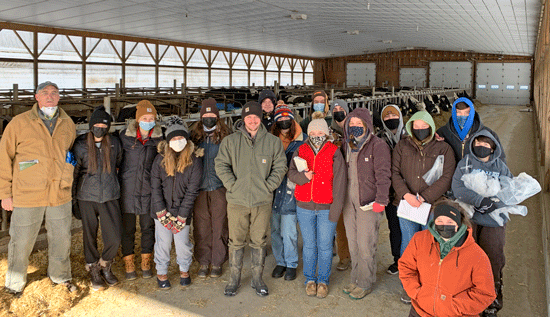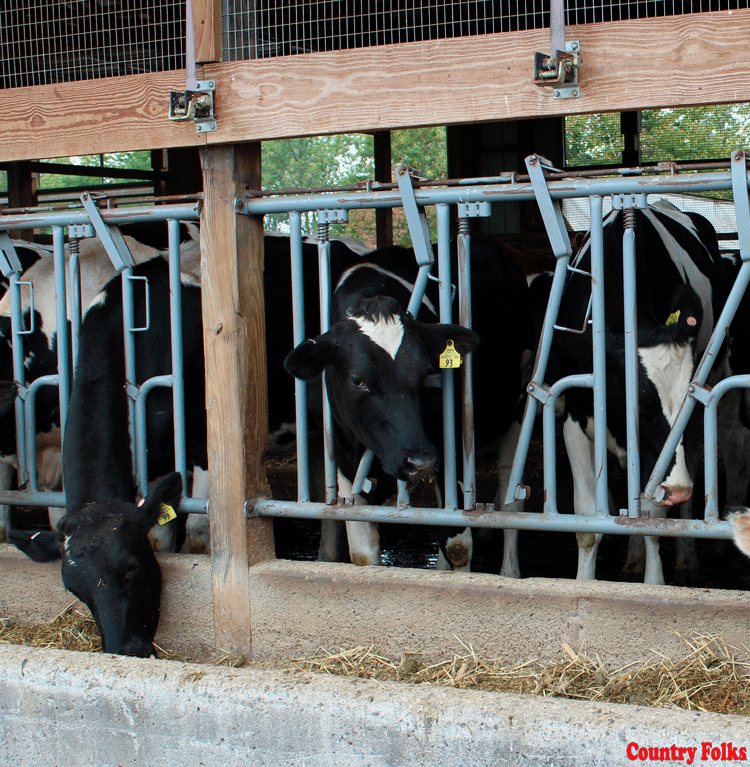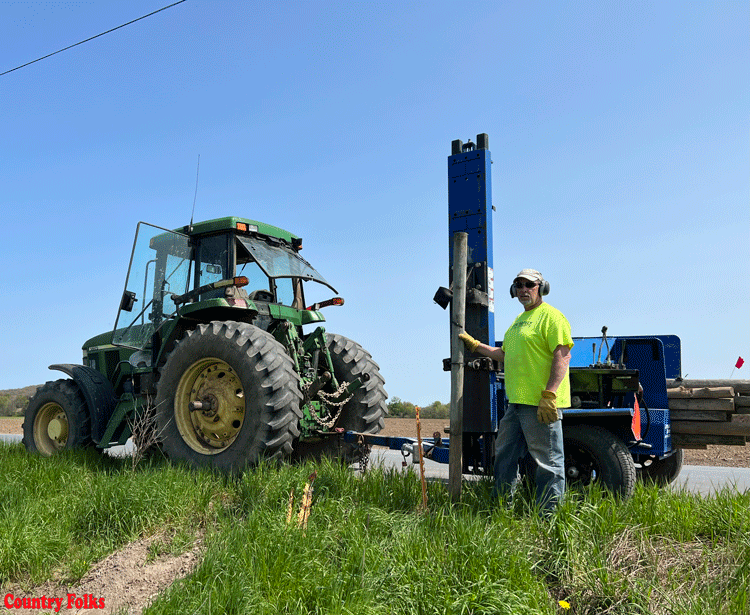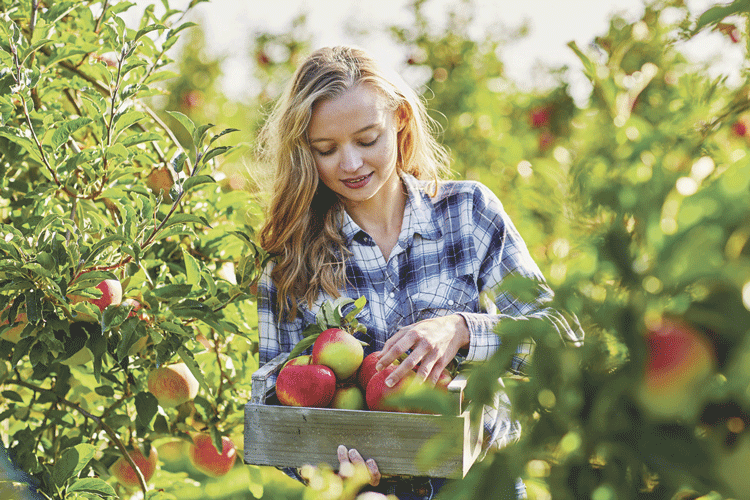by Danielle DeBlois, UNH
After a long two years, once again there was a dairy travel course that included the University of New Hampshire, University of Maine and UMass-Amherst. These universities came together to tour some of New Hampshire’s farms with support from Farm Credit Northeast AgEnhancement.
We began our tour at UNH’s dairy, Fairchild Dairy Teaching Center. This facility has Holsteins with 100 heifers and close to 90 cows in milk with milk getting shipped through DFA. At UNH, there were two studies underway in the milk cow herd, and another being run with the heifers. Along with this research, there is also a CREAM (Cooperative Real Education in Agricultural Management) program that manages around 25 cows and cares for the calves and heifers. UNH also has an organic Jersey herd whose milk is shipped to Organic Valley. This herd is a closed herd milking around 55 cows and around 40 heifers. This facility has around 275 acres, 55 of which are dedicated to pasture. In addition, they also conduct research, with Tess Stahl just finishing up one on Jersey colostrum.
We ended our first day on the tour with Cold Springs Milking Shorthorns in Farmington, NH. This herd boasts many show cows and has done well in the aspect of genetics. In addition to this, they also house a Delaval robotic milking system for their herd of Milking Shorthorns whose milk goes to the Hood plant in Concord, NH. Courtney Gould, owner and UNH alumna, gave us the tour and told us of the journey that they took to get to this farm from Salisbury, MA, to Farmington, NH.
On our second day, we started at Echo Farm in Hinsdale, NH. This farm makes and distributes pudding all around the Northeast. From starting as a 4-H project, this farm’s primary focus was on cow health and making sure that their product could come from the best facility possible. This farm follows the FARM act and certified humane project very closely to ensure to their consumers that their pudding is coming from nothing but the best. This farm, comprised of Milking Shorthorns and Jerseys, also has a robotic milking system from Lely. This made for a very interesting ability to see different companies’ systems in action.
Next, we visited Windyhurst Farm in Westmoreland, NH, where they have a closed Holstein herd of about 325 cows, 250 of which are in milk. This facility made a more updated parlor, which can provide more statistics to the staff and help with milk times, identification and being able to view components such as fat, protein and somatic cell count. This multigenerational farm also boasts a maple sugaring company as well and a restaurant that they run.
The next stop was Crescent Farm, which houses around 300 milking cows, primarily Jerseys. These Jerseys average around 60 – 70 pounds of milk and are taking part in Stahl’s colostrum project. This project is looking into the colostrum yield of Jerseys during winter months. The heifers are raised in this facility and rotate through many different housing types from individual pens to hutches to group housing, helping them to adjust and thrive at every step of life.
Our last stop of the day was at Cadillac Farm in Alstead, NH. This farm houses Jerseys with some high genetic merit. This herd has quite a few show animals and stays on top of a rigorous breeding program where if the animal does not fall into the highest percent of the cows on the farm, she will be bred to beef, which will be sold. This allows for only the best to stay and support the farm.

Students from UNH, UMaine and UMass-Amherst came together to tour a variety of differently operating dairy farms in New England during the Winter Dairy Travel Course. Photo courtesy of UMass Dept. of Veterinary & Animal Science
We started our third day at Pine Lane Farm in Contoocook, NH, which is an entirely Holstein herd of about 235 milk cows and 450 head total. This farm was very serious about their nutrition. They highly valued the nutrition of their cows. They focused heavily on making sure that they could make their own ration and adjust the ration as needed, keeping components such as minerals, palmitic acid and a mycotoxin binder on hand to be able to make a quick correction to a diet. This farm also feeds its calves pasteurized milk done with a pasteurizer in their parlor.
Our next farm was Morrill Farm Dairy in Concord, NH, which is home to an all-Holstein herd with many excellent scoring cows in the herd. This farm also has started to diversify its operation. They run a snow plowing business, sell farm-raised beef and grow small grains. They also are heavy into supporting legislature to help farmers. They urge consumers to look at the codes on their milk to know where their milk is coming from (and to check your milk for Code 33 – New Hampshire’s own milk). This farm also has a milk taxi where their milk is pasteurized and then hooked onto an ATV to carry it to the calves.
On our next stop, we visited Fernald Farm in Nottingham, NH, an entirely Holstein herd milking around 175 cows. This farm sends its heifers to be raised at a custom heifer grower. This farm, because of its location close to a lake, has had to focus a lot on manure management. They have a confined manure storage area as well as more waste filtration. This farm, having very few employees, knows its cows very well. They use activity collars for heat detection as well as being able to identify cows who may not be feeling well through a pedometer. These cows can then be identified for closer viewing.
We began our fourth day at Sanctuary Farm in Sunapee, NH. This farm ran a 40-Holstein cow tie-stall barn with component feeding. This herd was fed with dry hay as well as grain added to the hay, and they had a herd average of 90 – 100 pounds of milk a day. In addition to this high average, their milk components were also high, with a 4.3% fat and a 3.1% protein. With this, they are making their own ice cream and are in the process of putting in an industrial kitchen for a restaurant-style facility. This farm also has such a clean and dry facility that they have never had a hoof trimmer on their farm. This, in combination with using white pine shavings and allowing their cows to go outside frequently, allows for great hoof health.
Our next stop was MacGlaflin Farm in Claremont, NH, a mixed herd of 480 milk cows including Holsteins, Jerseys and Brown Swiss. A unique thing about this farm is that they leave the calf with the dam for a good amount of time after the calf is born. These calves are still fed colostrum and are given their vaccines but get to remain with their mother for a while. This farm was also all about change. They wanted to see a change in the industry for the betterment and wellbeing of animals. This farm strongly believes that polled is the way that most farms should be breeding and that there is no need for calves with horns. In addition, they believe that group housing from almost birth is a very good way to raise calves and that calves should be fed until they are full, not a set amount. This leads to big, strong, healthy calves for this farm.
Our next stop was Tullando Farm in Orford, NH, a Holstein herd milking around 450 cows. This farm milks with eight Lely robots with cows averaging around 85 pounds a day. They also have a manure separator, so their bedding is primarily recycled manure solids and their liquids return to a collection tank. This separator is fed by the constantly moving alley scrapers, which feed into a system to bring the manure to the separator. After being separated they will let the solids sit for a day at least before using them. This farm also has a high composition of excellent genetics, with a few excellent scoring cows running throughout the herd. This farm also has had a record-holding cow (with Tullando Royalty Maxima holding the milk production record for December 1992 and not being beat again until August 1993).
Our last stop of the day was Harkdale Farm in Newbury, VT, a 160-cow Holstein and Jersey herd. This family-owned farm has a strong focus on breeding pretty show animals. On this farm, there are several excellent scoring cows within the breeds. To keep up with these genetics they only breed the top 10% – 15% of the herd and some of the lower percentage cows are used as donors for embryos. Calf care was also a huge focus on this farm, with the belief being that if you have a healthy, well-maintained rumen in your calf later down the line you will have a healthier cow. These calves are not fed fermented feeds until they are around eight to nine months old and are kept on calf starter, heifer pellets, beet pulp and hay until they reach this age to allow their rumen to develop. These calves are also fed until they are full for the first four to five weeks of life and are fed transition milk. With all these things, they have noticed that they can breed and see heats earlier as well as have more productive cows.
On our last day, we went to Yawnoc Farm, a family-run Brown Swiss herd, with a few Dutch Belts, in Jefferson, NH. This farm had also started as a 4-H project and has now grown to have 48 milking cows. This herd is fed strictly dry hay and grain, with all nutrition being done in-house by Dave and his brother Kevin Conway. This farm also houses four excellent scoring Brown Swiss in its barn with quite a few 87- and 88-point cows as well. With Brown Swiss, they have the market for selling bull calves to be used for oxen, so they never breed polled for the chance that the calf could be used as an ox. In addition, they sell a few heifers a year. This farm, being a tie-stall, also has pastures for rotational grazing.
Our last stop on the tour was Forbes Farm in Lancaster, NH. This herd has about 1,300 milking Holstein cows, with a few crosses. Unlike most farms we viewed on this tour, they run a bull in with their cows for breeding instead of using AI. These bulls are genomically tested and they have strict requirements for selecting their breeding bulls. This farm, having so many cows, also has a milk silo to store their milk in between DFA pick ups. Another project done on this farm was a beef raising project that figured out feeding beef on shelled corn and a protein mix through a self-feeder can be finished in 13 – 14 months, with minimal physical labor due to there not being a lot of manure to pick up as well as not having to feed as often.
Some common themes throughout these farms were a focus on better, more efficient farming. Each farm had a way of monitoring their cows, whether it be physical observation, activity collars or pedometers. In addition, there was a shift to focus on the dry cow more. Each farm had a different way of feeding a dry cow diet but in total there was a special interest being given to this group at the farms. The last common thing was all the farms wanting to teach about what they truly love and care about. Each farm realized without the education of the next generation in the dairy industry there would be no place for the industry to go.
On behalf of all the students and faculty attending this trip, I would like to thank all the farmers who allowed us to tour their facilities and teach us more about the industry. In addition, I would like to thank Farm Credit Northeast AgEnhancement East for their gracious sponsorship that allowed us to tour these farms and get to learn more about the dairy industry.










Leave A Comment